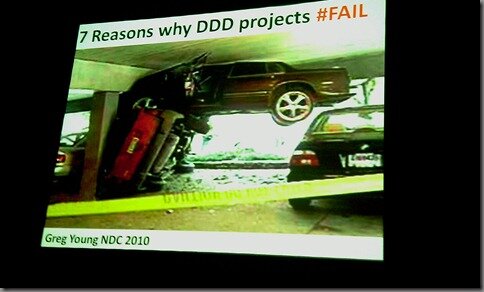
#1 Lack of intent
You build a system but you do not find out what the intention of the user is. It is visible by domain models that are empty from business logic. There will only be four verbs, CRUD which doesn’t tell you anything about what the user wanted to do.
#2 Anemic Domain Model
A model that looks and smell like a real domain model, but when you are looking for behavior you can’t find it. You have domain services that becomes transaction scripts on top of your Domain Models. It’s not an anti-pattern but it’s not DDD either. Anemic Domain Models work wells in teams with little OO skills in a simple model, but usually they are bad.
#3 DDD-Lite
Using DDD as a pattern language, you do not define context you just implement patterns. If you are a .NET developer and you are running down this path, stop. You either need to do real DDD or something simpler. The middle road is problematic. DDD-Lite will give you all of the overhead and none of the benefits.
Naming things is really important, the value is not in the domain model. The domain model is only a representation of the ubiquitous language. So if the language is not there, the competitive advantage will not surface.
#4 Lack of isolation
Part of why building domain models are expensive is because we want them isolated from everything else. But without it, there will be abstraction leakage left and right.
Example, We might get back 300 fields in our XML but we are only using two. Our domain model should only have those two.
Another example, UoW is really a infrastructure concern why would you bring that into the domain?. If you have your aggregate boundaries right, you don’t need a unit of work.
#5 Ubiquitous what?
The ubiquitous language is only ubiquitous in a context. If you aren’t using bounded context, you will fail with defining the language. The way to find contexts is to find places where word have different meaning. We need to break things apart and focus on our context boundaries.
#6 Lack of refinement
Most projects do not come back to the domain model and do any refinement. The team learns more about the domain, but do not go back and update the model with the new knowledge. A year down in the project you will be translating the model to the domain experts and the ubiquitous language will be lost.
Since the domain model is a tool to analyze the domain and solve problems, it has to be clean and reflect the level of understanding we have of the domain.
#7 Proxy Domain Expert (Business analyst)
Each level of translation a little more get lost. If we are using a proxy domain experts, what’s really happening is that we have two ubiquitous languages. One from the BA to the real domain expert, one from the BA to the developers. What’s the chances they are the same?
A BA shouldn’t be in the middle, they should work as a facilitator and help developers and the domain experts to communicate and get closer to each other.
Reflections
I’ve been in project where all 7 of these failures has emerged in one way or another. It ties into what Eric Evans have been talking about a lot today and most of SOLID principles. Make sure you have clear context where models make sense and clear separation of concerns and you’ll be in a good starting position.
I also reflect over the fact that most failures are based on communication and the expression of what get’s communicated. So much in software development are really not about technology, but yet as the engineers we are, we try to make it about that.

